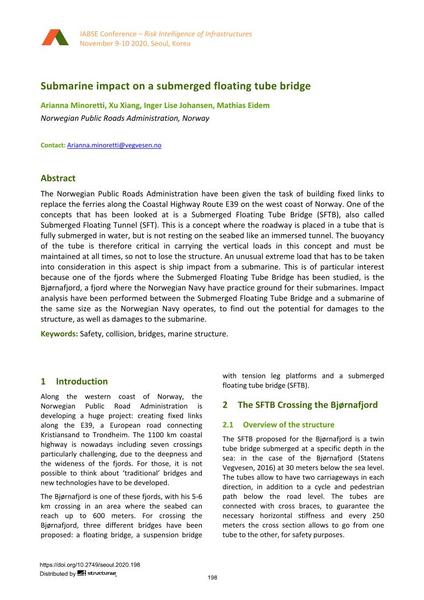Submarine impact on a submerged floating tube bridge

|
|
|||||||||||
Détails bibliographiques
| Auteur(s): |
Arianna Minoretti
(Norwegian Public Roads Administration, Norway)
Xu Xiang (Norwegian Public Roads Administration, Norway) Inger Lise Johansen (Norwegian Public Roads Administration, Norway) Mathias Eidem (Norwegian Public Roads Administration, Norway) |
||||
|---|---|---|---|---|---|
| Médium: | papier de conférence | ||||
| Langue(s): | anglais | ||||
| Conférence: | IABSE Conference: Risk Intelligence of Infrastructures, Seoul, South Korea, 9-10 November 2020 | ||||
| Publié dans: | IABSE Conference Seoul 2020 | ||||
|
|||||
| Page(s): | 198-204 | ||||
| Nombre total de pages (du PDF): | 7 | ||||
| DOI: | 10.2749/seoul.2020.198 | ||||
| Abstrait: |
The Norwegian Public Roads Administration have been given the task of building fixed links to replace the ferries along the Coastal Highway Route E39 on the west coast of Norway. One of the concepts that has been looked at is a Submerged Floating Tube Bridge (SFTB), also called Submerged Floating Tunnel (SFT). This is a concept where the roadway is placed in a tube that is fully submerged in water, but is not resting on the seabed like an immersed tunnel. The buoyancy of the tube is therefore critical in carrying the vertical loads in this concept and must be maintained at all times, so not to lose the structure. An unusual extreme load that has to be taken into consideration in this aspect is ship impact from a submarine. This is of particular interest because one of the fjords where the Submerged Floating Tube Bridge has been studied, is the Bjørnafjord, a fjord where the Norwegian Navy have practice ground for their submarines. Impact analysis have been performed between the Submerged Floating Tube Bridge and a submarine of the same size as the Norwegian Navy operates, to find out the potential for damages to the structure, as well as damages to the submarine. |
||||
| Mots-clé: |
ponts
|
||||
